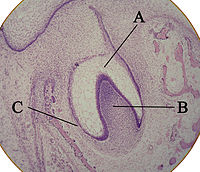
Photo from wikipedia
AIM To use the connectivity map, a bioinformatics approach, to identify compounds that could induce odontogenic differentiation of dental pulp cells (DPCs) and to experimentally validate this effect. A subsidiary… Click to show full abstract
AIM To use the connectivity map, a bioinformatics approach, to identify compounds that could induce odontogenic differentiation of dental pulp cells (DPCs) and to experimentally validate this effect. A subsidiary aim was to investigate the anti-inflammatory effect of any identified compound. METHODOLOGY The Gene Expression Omnibus (GEO) database was searched for microarray datasets assessing odontogenic differentiation of human DPCs. An odontogenic gene expression signature was generated by differential expression analysis. The statistical significant connectivity map (ssCMap) method was used to identify compounds with a highly correlating gene expression pattern. DPCs were treated with the compound identified and osteo/odontogenic differentiation was assessed by alizarin red staining, alkaline phosphatase activity and expression of osteo/odontogenic genes ALPL, RUNX2, COL1A1, DSPP, DMP1 and SPP1 by RT-PCR. The anti-inflammatory effect of the compound was assessed using an ex vivo pulpitis model and cytokine levels were measured with multiplex assay. Means were compared using the t- test or ANOVA followed by a Bonferroni post hoc -test with the level of significance set at p ≤ 0.05. RESULTS The GEO database search identified a specific gene expression signature for osteo/odontogenic differentiation. Analysis using the ssCMap found that acetylsalicylic acid (ASA)/aspirin was the drug with the strongest correlation to that gene signature. The treatment of DPCs with 0.05 mM ASA showed increased alkaline phosphatase activity (p < 0.001), mineralisation (p < 0.05), and increased the expression of the osteo/odontogenic genes, DMP1 and DSPP (p < 0.05). Low concentration (0.05mM) ASA reduced inflammatory cytokines IL-6 (p < 0.001), CCL21 (P < 0.05) and MMP-9 (p < 0.05) in an ex vivo pulpitis model. CONCLUSIONS Connectivity mapping, a web based informatics method, was successfully used to identify aspirin as a candidate drug that could modulate the differentiation of DPCs. Aspirin was shown to induce odontogenic differentiation in DPCs in vitro and this, together with its anti-inflammatory effects, makes it a potential candidate for vital pulp therapies.
Journal Title: International endodontic journal
Year Published: 2020
Link to full text (if available)
Share on Social Media: Sign Up to like & get
recommendations!